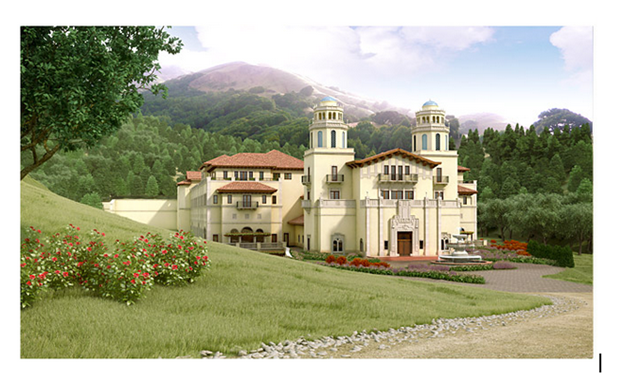The wages of California city planning spare no man—not even George Lucas. As recently as late 2020, the filmmaker sued the California town of San Anselmo to clear up a “surveying error” that may revert a portion of his property to the heirs of its 1920s owners. It’s a trivial dispute, even by the low standards of Bay Area planning. But it’s yet another episode in an ongoing war between Lucas and California’s infamously exclusionary Marin County, a conflict which has cast the creator of Star Wars and Indiana Jones as a reluctant YIMBY.
Our story begins a long time ago in a municipality not so far away. In 2011, Lucas proposed a significant expansion to his Skywalker Ranch production facility, revising plans which had been approved back in 1995. Local homeowners balked, claiming that the new structure—a three-story, Mission-style building which wouldn’t be out of place on the planet Naboo—was a poor aesthetic fit for the valley. Despite being largely hidden from view and surrounded by a pastoral landscape, Lucas was ultimately forced to withdraw the expansion proposal under mounting pressure from nearby property owners. Within a year, Lucas would sell the Star Wars franchise to Disney.

A rendering for Lucas’ scuttled 2011 proposal; it should be clear by the architecture that the director truly does think of Marin County as Naboo. Retrieved from gradyranch.com via the Wayback Machine.
The year 2015 saw Lucas strike back where it hurt Marin County NIMBYs most, making arrangements to dedicate a portion of his 1,039-acre estate for affordable housing. The plan called for 224 apartments, along with generous residential amenities and a new bus stop, designed for those service workers and public employees otherwise priced out of one of America’s most expensive communities. With a price tag of $150 million, the Grady Ranch housing proposal would have been the “largest privately financed affordable housing project in the country.”
Whether the project was born out of revenge—a path which Yoda might caution leads to the dark side—or an earnest passion for housing affordability remains unclear. In Lucas’ defense, it wouldn’t have been the director’s first foray into philanthropy: After all, the filmmaker donated much of the $4.08 billion payout earned from the sale of Star Wars to charitable causes. And with Marin County sporting some of the highest housing costs in the country, building affordable housing was undoubtedly a worthy cause.
But if it was all just about revenge, Lucas couldn’t have picked a better cause: If there’s anything that upsets Marin County residents more than an unsightly production studio, it’s new housing. For all its self-styled progressivism, the county remains a bastion of segregation, the natural result of decades of local opposition to new construction. As if on cue, neighboring property owners quickly threatened Lucas with a $70 million environmental lawsuit if the filmmaker didn’t pull back his housing plans. True to California planning tradition, the project remains in limbo five years later.
The Grady Ranch affordable housing proposal may have been Lucas’ most high-profile clash with Marin County NIMBYs, but it wasn’t his last. In late 2019, property owners in nearby Nicasio brought legal action against a proposed vineyard on Lucas-owned property, despite the proposal having received a permit from the county as an “as-of-right” use of the land. As with the pushback over Lucas’ scuttled 2011 studio expansion, complaints centered on the aesthetic harm that a vineyard would inflict on the hamlet, located just 10 miles south of California’s famous Sonoma Wine Country.
By any reasonable metric, Lucas has been a decent enough neighbor since arriving in Marin County in 1978, and an exemplary environmental steward, conserving over 4,000 acres of open space. And yet, across all of the filmmaker’s proposals, neighboring property owners have cloaked their opposition behind suspect environmental concerns. As urban scholar Bernard Frieden first documented in the late 1970s, San Francisco’s low-slung suburbs were patient zero when it comes to the cynical use of environmental law to stop unwanted development—especially housing.
The residents of Marin County would no doubt like to cast their ongoing war with George Lucas as a story of courageous rebels thwarting an evil empire. But perhaps the more apt metaphor can be found in the prequels: When it comes to an institution in decline, the line between good and evil is rarely so black and white.
